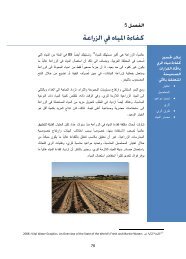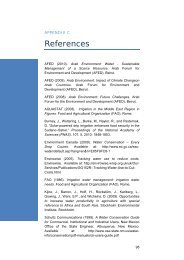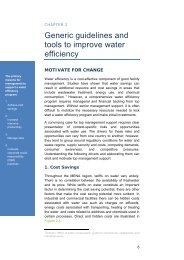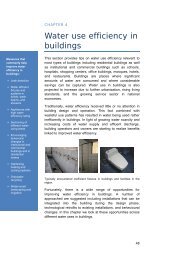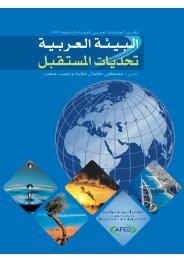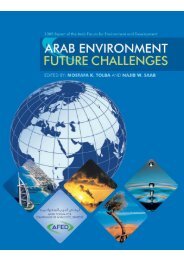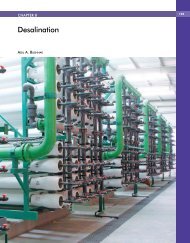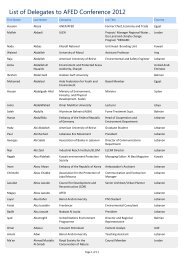Impact of Climate Change on Arab Countries - (IPCC) - Working ...
Impact of Climate Change on Arab Countries - (IPCC) - Working ...
Impact of Climate Change on Arab Countries - (IPCC) - Working ...
Create successful ePaper yourself
Turn your PDF publications into a flip-book with our unique Google optimized e-Paper software.
ARAB ENVIRONMENT: CLIMATE CHANGE<br />
XI<br />
INTRODUCTION<br />
<strong>Arab</strong> Envir<strong>on</strong>ment:<br />
<str<strong>on</strong>g>Climate</str<strong>on</strong>g> <str<strong>on</strong>g>Change</str<strong>on</strong>g><br />
2009 Report <str<strong>on</strong>g>of</str<strong>on</strong>g> the <strong>Arab</strong> Forum for Envir<strong>on</strong>ment and Development (AFED)<br />
<str<strong>on</strong>g>Impact</str<strong>on</strong>g> <str<strong>on</strong>g>of</str<strong>on</strong>g> <str<strong>on</strong>g>Climate</str<strong>on</strong>g> <str<strong>on</strong>g>Change</str<strong>on</strong>g> <strong>on</strong> <strong>Arab</strong> <strong>Countries</strong><br />
Main Findings and C<strong>on</strong>clusi<strong>on</strong>s<br />
MOSTAFA K. TOLBA AND NAJIB W. SAAB<br />
Ours is a habitable planet because <str<strong>on</strong>g>of</str<strong>on</strong>g> a combinati<strong>on</strong> <str<strong>on</strong>g>of</str<strong>on</strong>g> c<strong>on</strong>diti<strong>on</strong>s c<strong>on</strong>genial to<br />
life. Earth’s climate is c<strong>on</strong>ducive to life because atmospheric greenhouse gas c<strong>on</strong>centrati<strong>on</strong>s,<br />
most notably CO2, trap a porti<strong>on</strong> <str<strong>on</strong>g>of</str<strong>on</strong>g> the sunlight reflected <str<strong>on</strong>g>of</str<strong>on</strong>g>f its surface,<br />
thereby warming the planet. Since the Industrial Revoluti<strong>on</strong> human activities<br />
– in particular, fossil fuel usage, land use patterns, agriculture and deforestati<strong>on</strong><br />
– have increased greenhouse gas c<strong>on</strong>centrati<strong>on</strong>s in the atmosphere, causing<br />
average temperatures to rise. That the climate is actually changing is now a globally<br />
accepted fact; even the few opp<strong>on</strong>ents who still deny that it is man-made<br />
agree that it is happening, but as a manifestati<strong>on</strong> <str<strong>on</strong>g>of</str<strong>on</strong>g> a natural cycle.<br />
By 2007, the Intergovernmental Panel <strong>on</strong> <str<strong>on</strong>g>Climate</str<strong>on</strong>g> <str<strong>on</strong>g>Change</str<strong>on</strong>g> (<strong>IPCC</strong>), the United<br />
Nati<strong>on</strong>s’ scientific body <strong>on</strong> the issue, stated with high certainty that human causes<br />
lay behind most <str<strong>on</strong>g>of</str<strong>on</strong>g> the observed global temperature increases. Atmospheric<br />
CO2 c<strong>on</strong>centrati<strong>on</strong>s have increased from approximately 280 ppm (parts per milli<strong>on</strong>)<br />
in the pre-industrial age to around 430 today. At the level <str<strong>on</strong>g>of</str<strong>on</strong>g> 550 ppm,<br />
which could be reached as early as 2035, global average temperatures may rise by<br />
more than 2°C. Under a business-as-usual (BAU) scenario, the stock <str<strong>on</strong>g>of</str<strong>on</strong>g> greenhouse<br />
gases could more than triple by the end <str<strong>on</strong>g>of</str<strong>on</strong>g> the century, giving at least a<br />
50% risk <str<strong>on</strong>g>of</str<strong>on</strong>g> temperatures rising by more than 5°C during the decades to follow.<br />
The scale <str<strong>on</strong>g>of</str<strong>on</strong>g> such an increase could be illustrated by the fact that the climate is<br />
presently 5°C warmer than in the last ice age, which was over 10,000 years ago.<br />
The amount <str<strong>on</strong>g>of</str<strong>on</strong>g> carb<strong>on</strong> held in the oceans has increased, causing gradual but<br />
steady acidificati<strong>on</strong> that threatens marine ecosystems. Warmer water temperatures<br />
have also caused much coral bleaching. Increasing average temperatures<br />
have steadily caused melting <str<strong>on</strong>g>of</str<strong>on</strong>g> ice in the polar regi<strong>on</strong>s as well as <str<strong>on</strong>g>of</str<strong>on</strong>g> glaciers<br />
around the world. Warming ocean waters may cause the sea level to rise by up to<br />
59 cm by 2100 according to <strong>IPCC</strong> 2007 estimates, or even up to 5 metres if the<br />
melting <str<strong>on</strong>g>of</str<strong>on</strong>g> the Antarctic ice sheet is taken into c<strong>on</strong>siderati<strong>on</strong>.<br />
The <strong>IPCC</strong> predicts that 20 to 30% <str<strong>on</strong>g>of</str<strong>on</strong>g> species will be made extinct if the temperature<br />
increases by more than 1°C, which is already virtually unavoidable.<br />
Extreme weather events and variability will also likely to ensue.



